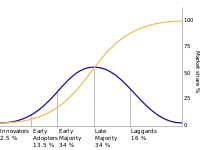
Photo from wikipedia
The potential role of innovation and knowledge networks in regional growth and development is well recognized. However, there has been scant reflection on its role as a policy mechanism, specifically… Click to show full abstract
The potential role of innovation and knowledge networks in regional growth and development is well recognized. However, there has been scant reflection on its role as a policy mechanism, specifically for peripheral regions. In response, this paper investigates the role of innovation and knowledge networks as a policy mechanism towards more resilient peripheral regions. Through a multiple country policy analysis, the paper determines to what extent innovation and knowledge networks are reflected in regional development policies of 17 OECD countries with predominantly rural characteristics. Moreover, the role of innovation and knowledge networks towards more resilient regions is quantified and measured for a specific peripheral region case in South Africa as developing country. The research ultimately concludes that the innovation and knowledge network mechanism of resilience, is dependent both on the extent and the quality of the innovation network within a region. It has been established that the mere presence of infrastructure (passive information communication technology - ICT) cannot specifically be associated with high levels of innovation and technological advantage, but rather a mind-set of change, being open to possibilities and ready for innovation injections (readiness ICT). In establishing a knowledge-rich region informed by both active and passive ICT, but with a pertinent focus on readiness ICT, a region with higher adaptability is established. This results in a peripheral region receptive to change, new technology and innovation. Primary policy actions such as the creation of Special Economic Zones (SEZs), skills training initiatives, centres of expertise, business development, and venture capital will promote innovation and knowledge networks as key actions towards more resilient peripheral regions.
Journal Title: Land Use Policy
Year Published: 2020
Link to full text (if available)
Share on Social Media: Sign Up to like & get
recommendations!